August 31 - September 6, 2014: Issue 178
Jack Spurling’s – ‘Tamar’ – 1923
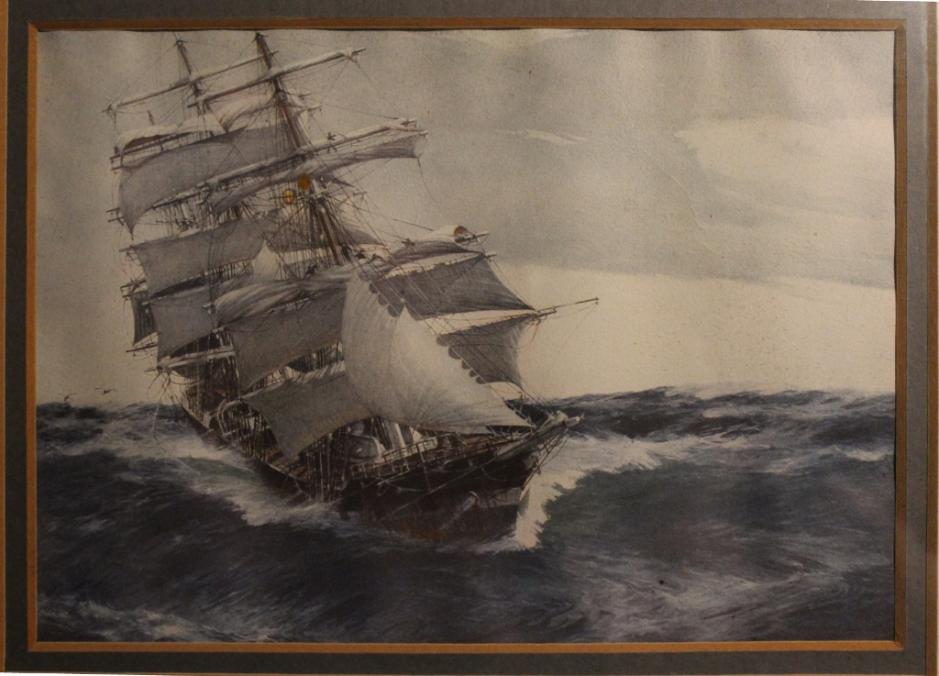
Our copy of Jack Spurling's 'Tamar'
Marine Artist Jack Spurling’s – 'Tamar' – 1923
John (Jack) Robert Charles Spurling (12th December 1870 – ? September, 1933) was a man who loved his ships. A print of one of his works is among the marine artist’s works we have gracing our walls here, inspiring many of the stories we like to share with you.
This one is from 1923 and probably graced the cover of The Blue Peter: The Magazine of Sea Travel.
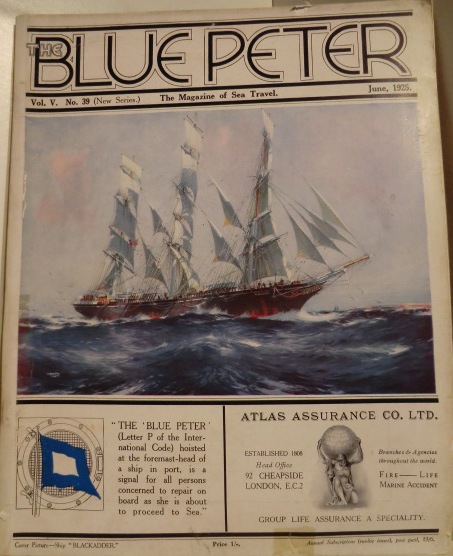 Launched in July 1921, The Blue Peter: The Magazine of Sea Travelpublished maps, historical articles, short fiction, and features on travel, yachting, and motor boats. Edited by A.M. and Frederick Arthur Hook, whose other publications included Merchant Adventurers, 1914-1918 (1920), Sail: The Romance of the Clipper Ships (1929), and Eastwards (1929). Photo-illustrations throughout, with full-colour advertisements and reproductions of paintings of sailing ships, it was to be found in the saloons of numerous passengers ships of the day.
Launched in July 1921, The Blue Peter: The Magazine of Sea Travelpublished maps, historical articles, short fiction, and features on travel, yachting, and motor boats. Edited by A.M. and Frederick Arthur Hook, whose other publications included Merchant Adventurers, 1914-1918 (1920), Sail: The Romance of the Clipper Ships (1929), and Eastwards (1929). Photo-illustrations throughout, with full-colour advertisements and reproductions of paintings of sailing ships, it was to be found in the saloons of numerous passengers ships of the day.
Right: The Blue Peter. The Magazine of Sea Travel. Vol. V. No. 39, June 1925 Perfect Paperback – Edited by F. A. Hook, F.R.G.S. and A. M. Hook, B. Sc. The Blue Peter. The Magazine of Sea Travel. Vol. V. No. 39, June 1925.
The one we have was of the Tamar.
TAMAR (1889 - 1923), 2,112 gross tons, length 286ft 6in, beam 42ft 5in, depth 24ft. Constructed of steel, built by Napier, Shanks & Bell, Dumbarton, for Devitt Moore - a three masted ship rigged steel vessel and the last ship built for that firm.
She was put in the Australian trade and did well with her cargo capacity of 4,000 tons. In 1898, she was unable to get a return cargo from Australia and took coal to San Francisco and returned with a cargo of wheat.
In 1900, she was sold to T.A Shute of Liverpool who put the ship in the South American trade. Carrying coal out and returning with nitrates from Chile. She survived World War I, and was in the wheat trade for a brief period after the War. She was laid up in 1921, and sold to ship breakers in 1923.
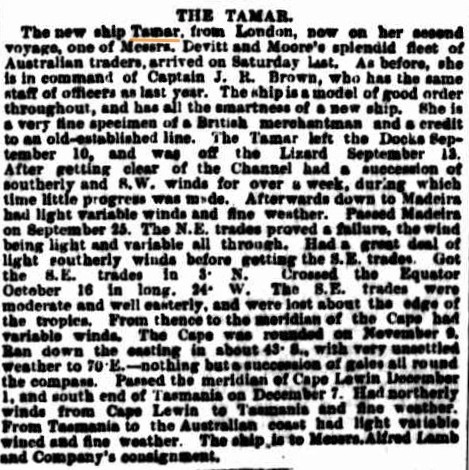
THE TAMAR. (1890, December 15). The Sydney Morning Herald (NSW : 1842 - 1954), p. 4. Retrieved from http://nla.gov.au/nla.news-article13797356
THE TAMAR. This well-known clipper, from London, is this time in Messrs., D Mitchell and Co, and anchored yesterday below Garden Island. She cleared the Channel on May 11. Had favourable winds to the equator June 5, in 21’W. The SE trades were poor On July 6 she passed the Cape , and came along 43’S , with heavy weather to Tasmania on July 31.. Since then contrary weather. She brings 208 tons of powder for the navy. THE TAMAR. (1900, August 6). The Sydney Morning Herald(NSW : 1842 - 1954), p. 8. Retrieved fromhttp://nla.gov.au/nla.news-article14328575
Born in Suffolk, John (Jack) Robert Charles Spurling was the son of a prosperous importer who dealt mainly in jute, the trade which gave the talented and aspiring artist his first contact with ships and the sea. During his youth in London, he occupied much of his time by sketching ships usually in the East India Docks at Blackwall until, at the age of sixteen, he went to sea aboard the ship ASTORIA, with a cargo of coal bound for Shanghai. He suffered a fateful fall from the yardarm and ended up hospitalized in China (Singapore). The period of recovery provided him with the opportunity to earn a second mate’s certificate, and he joined the Blue Anchor Line as a junior officer. He served for seven years, at some stages aboard Devitt and Moore ships (Sobraon was one of the ships on which Spurling served) many of which he later created works of.
After coming ashore, he first obtained work as an actor in George Edwards' musical productions, continuing with his painting as a hobby. His ship portraits came to the attention of Frederick Hook, the editor of the popular nautical magazine The Blue Peter. The publication of an initial selection of Jack's paintings proved an immediate success and Hook thereafter commissioned Spurling to produce many more works for the magazine which were published over a number of years.
A regular contributor to the same magazine was Basil Lubbock, one of Britain's leading maritime authors at the time, who, between the two World Wars, wrote a series of superlative books on the various aspects of commercial sail which many still regarded as the definitive record of a way of life that has now totally disappeared. In the mid-1920s, Lubbock and Spurling were approached by Frederick Hook to collaborate with him on a particularly interesting project which would come to be seen as one of the great milestones in the efforts to chronicle the history of commercial sailing ships. In his editor's preface, Hook wrote:
"This book does not claim to be a history of the clipper ships, although Mr. Lubbock's illuminating text sets out the salient points of the history and performances of typical vessels of the clipper ship era. One chief purpose has been adequately and handily to present a selection from amongst Mr. Spurling's pictures, painted for The Blue Peter, reproducing, by a special process, their original qualities of form, movement and colour."
The book produced was Sail, The Romance of the Clipper Ships, 3 volumes, London, 1927, 1929 & 1936, and subsequent reprints;Frederick Arthur Hook (editor), in collaboration with Basil Lubbock and John Spurling.
MR. JACK SPURLING. - Famous Painter Dead.
(BY "REDGUM.")
Mr. Jack Spurling, the marine artist, who, for many years, had been raiding old Davy Jones' lockers, salving ship souls that for one reason or another were consigned to his keeping, has made his last call on the super shellback of the oceans. Never again will the greatest shipowner of all time have to "shoo" him off the premises when he came, to rummage round In his old Junk shop for traces of this or that ship which Spurling was seeking.
Jack Spurling finished his lifework on the last day of May of this year, and dropped below the horizon a little before nightfall.
As a ship artist, he had no equal. Everything he touched leaped into life. Both the body and soul of the ships of yesterday came back again when he called them by name. And with the giant ocean-roving yachts which were admired by Old Neptune himself almost at his fingertips, he hurriedly, but wonderfully, pieced them together with pencil and pigment until even the one-eyed and toothless old sailor-men knew them at first sight.
SEVEN YEARS IN SAIL.
He worked for a long time as the special artist for "The Blue Peter," which his pictures accompanied into the harbours of the other ends of the earth. As a young lad, he went to sea, and served seven years in sail. It was there that he got the roar and the rhythm of the sea, and learned all that there was to learn of a ship's movement in calm or in storm.
He lived with his people in London some-where near the docks, where his sharp eyes filmed much that was to be of service to him in later years. At every opportunity he boarded the ships he fancied, seeing every-thing at first hand. One day, aboard the ship Mermerus, Captain Cole asked him what he was doing nosing about the ship.
"I like to watch the men at their work," replied young Spurling, as he put his drawing block and pencil into one of his pockets. "Some day, sir, I hope to go to sea."
Captain Cole laughed, and told the young stranger to "keep away from ships, for, as sure as God made little apples, they will get you."
Spurling's first ship was the Astoria. He had the misfortune to fall from the main upper topsail yard to the deck. That bad day's work kept him in Singapore Hospital for nearly six months. After recovering, the lad of 16 went into Devitt and Moore's employ, and after obtaining a second mate's certificate, saw service in the Blue Anchor line of steamers well known in the colonial trade.
From the sea, Jack Spurling took a turn on the stage, and climbed high in his profession. But all along he kept studiously on, giving a new life to a Yankee softwood heeler, like the Lightning pictured here, or to an old square-sterned sea puncher of the La Hague and Parramatta type, which were the safe, family ships on the Horn run in our boy days.
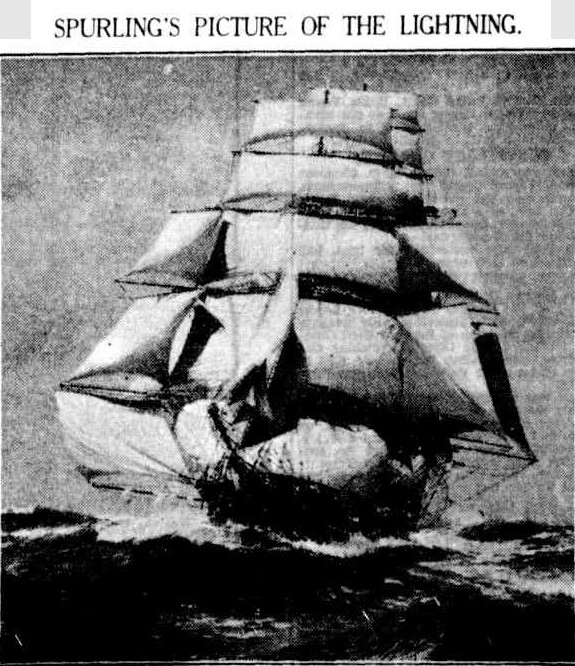
SPURLING'S PICTURE OF THE LIGHTNING. "She walks the water like a thing of life." — Byron. SPURLING'S PICTURE OF THE LIGHTNING. (1933, September 30). The Sydney Morning Herald (NSW : 1842 - 1954), p. 9. Retrieved from http://nla.gov.au/nla.news-article17011541
Mr. Donald McKay, of East Boston, the greatest builder of softwood ships the world has known, launched the Lightning during 1853, having fashioned her to the order of Mr. James Baines, of Liverpool, who founded the Australian Black Ball line to compete in the emigrant trade.
Her best work was done during hard weather, when she frequently logged 17 or l8 knots, without drowning the fo'c'sle hands or sweeping the navigating officers over the wind-ward poop rail. On one eventful day during her first run to Melbourne, she logged 436 miles. Her record run to the Horn from Port Phillip Heads of 19 days 1 hour, has never been beaten. The Lightning ended her days off the Geelong pier, being burned to the water's edge after having completed her home loading on October 31, 1869.
Leaving the stage, Spurling hunted steadily in the limbo of lost ships, and made the rolling blue oceans and the homes of the ship loving peoples of the earth alive again with the wonders and glories of a yesterday that, but for him, would never have come back again.
In doing that great work, Jack Spurling immortalised the sailing ships and the sea-men of the maritime nations of the earth. I sometimes think he must have pleased old Davy Jones himself, and the sea birds as well.
All my life, I have collected pictures of ships in full sail. Anything under canvas has always held my heart. I can well remember the days when I sat in a barber's chair and took in every line of a coloured American lithograph of some of the record-breaking American clippers which were hung on the walls of the shop of the man who had the privilege of bobbing my oakum-coloured head-gear. But those ship pictures were mere prints without artistic or poetic merit. Some of Jack Spurling's pictures, however, make me feel that it is time to get into souwester and sea boots.
EVERYTHING BUT THE NOISES.
Mr. Basil Lubbock wrote the stories which Jack Spurling later translated and put Into colour. Only the groans of the ships and the howl of the gales beat him. Whatever could be drawn he would set down.
Jack Spurling was the pilot who sailed many a pretty clipper ship through memory straits and anchored her again before the eyes of those who knew her best and loved her most.
One thing I am thankful for is that the dream of my boy days has come true with Jack Spurling. He, with his mastery of the sea, built up again the Cimba, a sweet green thing that always looked the heeler; the Tweed, so tall that I many a time wondered how the brass-bounders would reach her sky sail yards; tho Trafalgar, one of the most shapely of the ships carrying wool home from the antipodes; the Samuel Plimsoll, which every harbour sider held in reverence for her namesake; the Abergeldie, a Duthie ship, so shapely that I always thought her prettier than the Cutty Sark or the Thermopylae: the Pericles and the Patriarch, the Port Jackson, the Lock Torridon, the Mermerus, the Macquarie, sailed by my friend, Captain David Cairosso, a ship which still floats around the harbour with insight of the big Bridge, carrying the name Fortuna, and the Sobraon, giant of all the teak built ships that ever sailed the seas.
What a wonderful work for one man to do.
MR. JACK SPURLING. (1933, September 30). The Sydney Morning Herald (NSW : 1842 - 1954), p. 9. Retrieved fromhttp://nla.gov.au/nla.news-article17011551
‘Redgum’ was the pen-name or pseudonym of Jack G Lockley (Born: 1865 Sydney, New South Wales; Died: 18 May 1937 Sydney, New South Wales ) who started in the book trade working as a 'message-boy' for the Sydney bookseller William Maddock. He went on to manage the Sydney Book Club when it was established in 1895 and also edited the Amateur Gardener magazine. Mr. Lockley wrote gardening books, and using the pseudonym 'Redgum', 'wrote delightfully on gardening and kindred subjects for many years in the Sydney Morning Herald.'(James Tyrrell. Old Books, Old Friends, Old Sydney p.73).
In April and June of this year whole lots of Mr. Spurlings artworks were sold through Bonham’s and Christie’s of London respectively, both advertising these as The Marine Sale and Maritime Art. Pictures fetched between £25,200 (AU$ 44,864) and £6,000 - £8,000 ($10,026 - $13,368).
Even copies of Blue Peter fetch good prices nowadays, ranging from 30 Euros to £105.00 while prints sell from $70.00.
References and further:
blue peter - (nautical) A blue signal flag with a white rectangle in the centre, signifying "P". When flown alone, indicates that a ship is ready to sail, requiring all crew members and passengers to return on board.
Ships of Devitt and Moore: http://cityofadelaide.org.au/the-ship/the-owners/188-devitt-moore-ships.html
TAMAR Ship Steel Napier, Shanks & Bell, Dumbarton 1889 1889-1900 2,115 2,048 286.8 42.5 24.0
%20Robert%20Charles%20Spurling%20Argonaut.jpg?timestamp=1408752345843) LITERATURE:
LITERATURE:F.R.G.S.. The Royal Geographical Society (with the Institute of British Geographers) is the UK's learned society and professional body for geography, founded in 1830 for the advancement of geographical sciences. Today, it is a leading centre for geographers and geographical learning. The Society has 16,500 members and its work reaches millions of people each year. The Geographical Society of London was founded in 1830 under the name Geographical Society of London as an institution to promote the 'advancement of geographical science'. It later absorbed the older African Association, which had been founded by Sir Joseph Banks in 1788, as well as the Raleigh Club and the Palestine Association. The history of the Society was closely allied for many of its earlier years with 'colonial' exploration in Africa, the Indian subcontinent, the polar regions, and central Asia especially.
It has been a key associate and supporter of many notable explorers and expeditions, including those of Darwin, Livingstone, Stanley, Scott, Shackleton, Hunt and Hillary.]
The early history of the Society is inter-linked with the history of British Geography, exploration and discovery. Information, maps, charts and knowledge gathered on expeditions was sent to the RGS, making up its now unique geographical collections. The Society published its first journal in 1831 and from 1855, accounts of meetings and other matters were published in the Society Proceedings. In 1893, this was replaced by The Geographical Journal which is still published today.
The applicants of fellowship of the Society must be proposed and seconded by existing Fellows and elected by the Council. As the highest level of membership of the Society, Fellows are granted the right to use the post-nominal designation "FRGS" after their names.
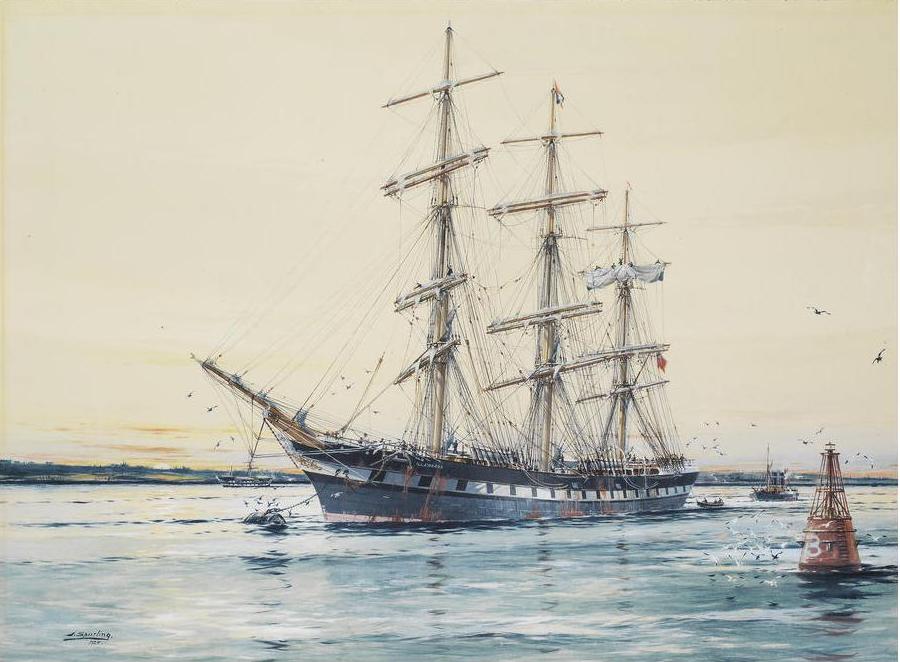
The Illawarra - Jack Spurling (British, 1871-1933)
The square-rigged Australian windjammer and, later, celebrated sail training ship Illawara lying on her mooring at sunset signed and dated, 'J Spurling 1925' (lower left) watercolour heightened with white 43 x 58cm (16 15/16 x 22 13/16in).
The Illawarra
In his text to Sail, The Romance of the Clipper Ships, Basil Lubbock wrote of her:
"The Illawara was constructed as a first-class iron cargo carrier rather than a fine-lined wool clipper or a handsomely-fitted passenger ship"......"easily capable of a 300-mile run [in a day] in the 'roaring forties', but slower"......"in light and moderate winds," .......whilst her 83-day dash home from Sydney, via Cape Horn, in 1893-94 was eulogised as "an exceedingly good piece of work for an iron ship."
An "exceedingly good piece of work" she certainly was and this atmospheric portrait of her by 'Jack' Spurling was the very one selected to accompany Lubbock's magisterial narrative (see volume II, section V, pp. 139-41, incl. plate). Indeed, it was the publication of Sail, The Romance of the Clipper Ships which first laid Spurling's work before a wider audience and, in effect, secured his reputation as a maritime painter of substance.
As to the ship herself, Illawara named for the coastal region of New South Wales, south of Sydney was built by Dobie & Co. at Glasgow and launched in October 1881. Registered at 1,963 tons gross (1,887 net) and measuring 269 feet in length with a 40 foot beam, she had some passenger accommodation but was primarily designed for cargo. Ordered for the already substantial fleet of Messrs. Devitt & Moore, one of the most prominent shipping companies operating the Australian trade, she was fitted out 'with no expense spared' and entered service with the distinctive green hull and 'painted ports' which characterised all her owners' ships. With Captain David Corvasso in command, Illawara cleared Liverpool on 12th January 1882 and arrived in Sydney on 29th April after a good though not exceptional passage of 107 days. With the American (west coast) grain trade with Europe booming at the time, Corvasso loaded coal for San Francisco where he arrived after a splendid run across the Pacific in only 51 days. After a quick turn-around,Illawara then sailed from the 'Golden Gate' on 31st October (1882) loaded with a brimming cargo of wheat and barley bound for Grimsby where she docked on 17th March the next year. A second voyage tracing a similar triangular course followed, after which she began regular runs out to Sydney carrying general cargo and returning directly home with wool, usually over 7,000 bales. She completed fifteen such round trips between 1884 and 1899 until, following the sale of their Hesperus, Devitt & Moore decided to replace her with Illawara as one of the company's two sail training ships.
After the untimely death of Captain Barrett on Illawara's first voyage with a cadet crew, Captain Maitland took over and remained in command for seven successful years until, in July 1907, Devitt & Moore sold the "fine old ship" to Norwegian owners who put her into the timber trade where she thrived for five more years. On 12th February 1912, she left Leith bound for Valparaiso but was so damaged in a storm in the Irish Sea that she was abandoned in a sinking condition off the Old Head of Kinsale on 7th March. Her crew was saved by the passing steamer Bangore Head but Illawara herself foundered soon afterwards.
Bonhams The Marine Sale 15 April Lot 138- JACK SPURLING (British, 1871-1933) The square-rigged Australian windjammer and, later, celebrated sail training ship Illawara lying on her mooring at sunset- Sold for £7,500 (AU$ 13,352) inc. premium
See more items that went at Bonham's The Marine Sale - London, Knightsbridge, 15th of April 2014, here:http://www.bonhams.com/auctions/21656/
Researched and compiled by A J Guesdon, 2014.